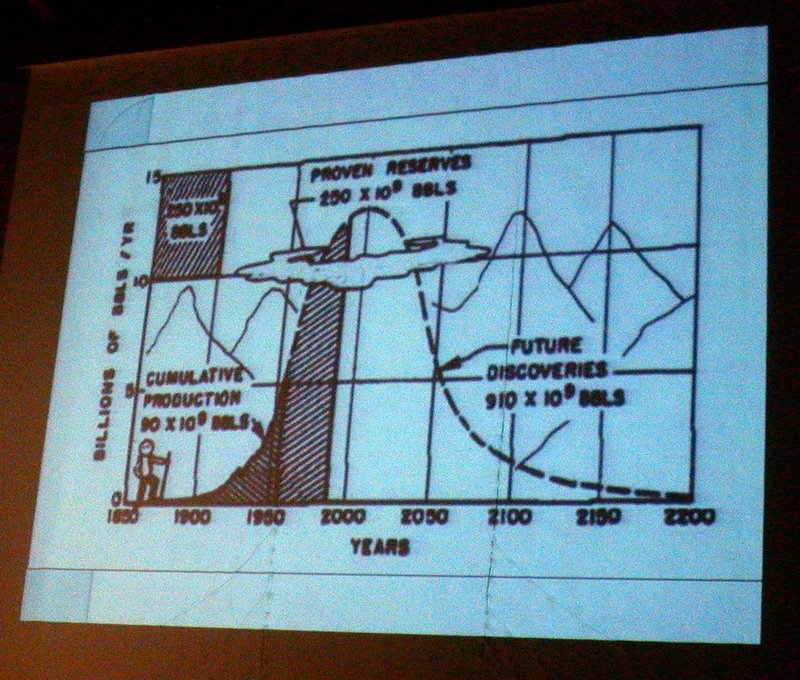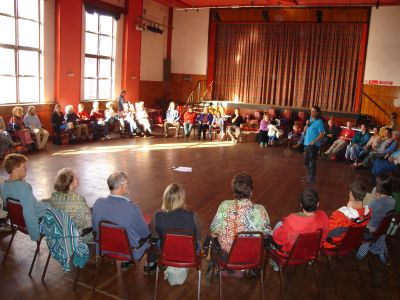Transition Culture has moved
I no longer blog on this site. You can now find me, my general blogs, and the work I am doing researching my forthcoming book on imagination, on my new blog.
Come find me at robhopkins.net
Archive for “Localisation” category
Showing results 436 - 440 of 684 for the category: Localisation.
2 Apr 2008
 ‘Health and Sustainability’ was a fascinating event, in two parts, which began to explore the implications on healthcare of peak oil and climate change. The first part was an online webcast held at Plymouth University, where the four speakers gave 10 minute online presentations and then discussed the issues raised online in a chatroom format. The webcast (I refuse to use the term ‘webinar’ which was used in the publicity!) turned out to be the most popular one that the University has ever run, with about 50 people from around the world, including New Zealand and the US, logging on to take part. It demonstrated new technology at its best, and offered a tool which could greatly reduce the amount of air travel that is required for communication.
‘Health and Sustainability’ was a fascinating event, in two parts, which began to explore the implications on healthcare of peak oil and climate change. The first part was an online webcast held at Plymouth University, where the four speakers gave 10 minute online presentations and then discussed the issues raised online in a chatroom format. The webcast (I refuse to use the term ‘webinar’ which was used in the publicity!) turned out to be the most popular one that the University has ever run, with about 50 people from around the world, including New Zealand and the US, logging on to take part. It demonstrated new technology at its best, and offered a tool which could greatly reduce the amount of air travel that is required for communication.
Read more»
31 Mar 2008
 We rely on oil for everything from transport to aspirins. By 2006 we were using 86 million barrels of oil a day: that’s an Olympic swimming pool of oil every 15 seconds. But one day soon supplies are going to run dry and, according to Rob Hopkins, we need to prepare for that crisis now. His “Transition movement” is about building communities that can stand on their own feet in a post-oil world. To do that you need to increase “resilience”, eco-speak for a system’s ability to cope with external shocks.
We rely on oil for everything from transport to aspirins. By 2006 we were using 86 million barrels of oil a day: that’s an Olympic swimming pool of oil every 15 seconds. But one day soon supplies are going to run dry and, according to Rob Hopkins, we need to prepare for that crisis now. His “Transition movement” is about building communities that can stand on their own feet in a post-oil world. To do that you need to increase “resilience”, eco-speak for a system’s ability to cope with external shocks.
Read more»
28 Mar 2008
 I missed the first speaker of the day, Alan Hobbett, whose talk was called “Community Power, the imminent revolution”, because I was doing an interview with Joanna Macy which I will post here as soon as I have transcribed it. After the break it was my turn. Taking to heart Jonathan’s request to rethink and reflect what had gone before, I think this was one of the most personal talks I have ever done. Something about being here and speaking here allows one to take risks, to feel held to push things that bit further.
I missed the first speaker of the day, Alan Hobbett, whose talk was called “Community Power, the imminent revolution”, because I was doing an interview with Joanna Macy which I will post here as soon as I have transcribed it. After the break it was my turn. Taking to heart Jonathan’s request to rethink and reflect what had gone before, I think this was one of the most personal talks I have ever done. Something about being here and speaking here allows one to take risks, to feel held to push things that bit further.
Read more»
27 Mar 2008
 I realise I am proving a fairly hopeless Positive Energy blogger, as I am already a day behind with my blogging duties (Rowan is being far more productive than I!), so I will try and catch up. On arriving at Findhorn it was suggested to me by Jonathan Dawson that I might in fact tear up the presentation that I had brought with me and instead do something which reflected the journey that the event took me on. It turned out to be a great suggestion, but it did mean that most of yesterday afternoon, the Open Space sessions, I missed, as I was working out my presentation. The morning, however, featured two wonderful presentations, by Megan Quinn (left) and Jonathan Dawson.
I realise I am proving a fairly hopeless Positive Energy blogger, as I am already a day behind with my blogging duties (Rowan is being far more productive than I!), so I will try and catch up. On arriving at Findhorn it was suggested to me by Jonathan Dawson that I might in fact tear up the presentation that I had brought with me and instead do something which reflected the journey that the event took me on. It turned out to be a great suggestion, but it did mean that most of yesterday afternoon, the Open Space sessions, I missed, as I was working out my presentation. The morning, however, featured two wonderful presentations, by Megan Quinn (left) and Jonathan Dawson.
Read more»
21 Mar 2008
 If you are a control freak, you will hate organising an Open Space event! It involves a lot of trust that the process will work but at the same time I have never seen or heard of one not working. Open Space is a powerful tool for engaging large groups of people in discussions to explore particular questions or issues. It can be used with groups from anything between 10 and 1,000 people. Open Space has Four Rules and One Law (the Law of Two Feet).
If you are a control freak, you will hate organising an Open Space event! It involves a lot of trust that the process will work but at the same time I have never seen or heard of one not working. Open Space is a powerful tool for engaging large groups of people in discussions to explore particular questions or issues. It can be used with groups from anything between 10 and 1,000 people. Open Space has Four Rules and One Law (the Law of Two Feet).
Read more»
 ‘Health and Sustainability’ was a fascinating event, in two parts, which began to explore the implications on healthcare of peak oil and climate change. The first part was an online webcast held at Plymouth University, where the four speakers gave 10 minute online presentations and then discussed the issues raised online in a chatroom format. The webcast (I refuse to use the term ‘webinar’ which was used in the publicity!) turned out to be the most popular one that the University has ever run, with about 50 people from around the world, including New Zealand and the US, logging on to take part. It demonstrated new technology at its best, and offered a tool which could greatly reduce the amount of air travel that is required for communication.
‘Health and Sustainability’ was a fascinating event, in two parts, which began to explore the implications on healthcare of peak oil and climate change. The first part was an online webcast held at Plymouth University, where the four speakers gave 10 minute online presentations and then discussed the issues raised online in a chatroom format. The webcast (I refuse to use the term ‘webinar’ which was used in the publicity!) turned out to be the most popular one that the University has ever run, with about 50 people from around the world, including New Zealand and the US, logging on to take part. It demonstrated new technology at its best, and offered a tool which could greatly reduce the amount of air travel that is required for communication.



